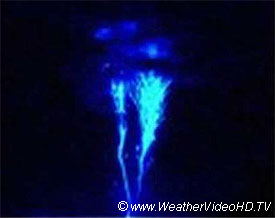Lightning phenomena: sprites, elves and blue jets
There are different types of lightning (or electrical discharges) that occur well above the realm of the thunderstorms that we experience in the troposphere (the lowest layer of earth’s atmosphere as it runs as high as about 17 km above earth’s surface). These discharges include but are not limited to what are called sprites, elves, and blue jets.

Sprites
Sprites are usually reddish-orange in colour and they come in various shapes (carrot, angel, and broccoli) but with hanging tendrils below. They often occur in clusters of three or more. Sprites generally occur high in the atmosphere at altitudes of around 65 to 75 km, but their tendrils can extend down to altitudes as low as 40 km. They are also very large; clusters of them can cover horizontal distances of 50 km across.
Sprites last only about three to ten microseconds and are only barely detectable to the unaided human eye and only under certain conditions (their brightness is about equivalent to moderate Northern Lights). This is why photographic evidence was needed before their existence could be fully verified.
Research indicates that sprites are associated with very powerful positive cloud-to-ground lightning strikes from dying thunderstorms. Researchers believe that these intense lightning strikes create an intense electrostatic field above the thunderstorm cloud. This creates a voltage difference between the cloud and the upper atmosphere, and a “spark” occurs in the form of a sprite.
Elves

Elves are huge red halos that occur high in the atmosphere at around 100 km above active thunderstorms. They can be up to 400 km in diameter and last only about a millisecond. Surprisingly, the existence of elves was predicted before one was actually observed. Their cause is similar to that of sprites, occurring in response to a large, intense lightning strike in a thunderstorm below. The electromagnetic discharge rises up from the storm and spreads out like a ripple from a pebble, near the transition between the stratosphere and the ionosphere.
Blue Jets

And there are even more!
There are even more mysterious, high atmospheric discharges associated with lightning and thunderstorms. Some of these are known as gnomes, trolls, pixies, blue starters and upward superbolts!